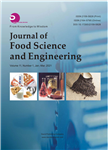Development of Cold-Chain for Postharvest Loss Reduction of Chinese Cabbage(Brassica campestris ***)
作者机构:Faculty of Agro-IndustryRoyal University of AgriculturePhnom Penh 12000-12401Cambodia Division of Research and ExtensionRoyal University of AgriculturePhnom Penh 12000-12401Cambodia Mid-Campus Drive NorthKansas State UniversityWeber HallManhattanKS 66506-8028United States Department of Food Science and TechnologyCollege of Agricultural and Environmental ScienceUniversity of California-Davis595 Hilgard LaneDavisCA 95616United States Science and Mathematics DivisionDepartment of BiologySierra College5100 Sierra College BoulevardRocklinCA 95677United States
出 版 物:《Journal of Food Science and Engineering》 (食品科学与工程(英文版)(美国))
年 卷 期:2021年第11卷第1期
页 面:9-22页
学科分类:0202[经济学-应用经济学] 02[经济学] 020205[经济学-产业经济学]
基 金:the generous support of the American People provided through the United States Agency for International Development(USAID)to the following:Building Safe Vegetable Value Chains in Cambodia Program through the Feed the Future Horticulture Innovation Lab for Collaborative Research at the University of California Davis,subaward No.09-002945-130 to KL and GMY the Borlaug Global Food Security Graduate Research Program as part of the U.S.government’s global hunger and food security initiative called Feed the Future,grant No.13076416 to KL and the Center of Excellence on Sustainable Agricultural Intensification and Nutrition(CE SAIN)of the Royal University of Agriculture through the Feed the Future Innovation Lab for Collaborative Research on Sustainable Intensification at Kansas State University(USAID)under Cooperative Agreement No.AID-OAA-L-14-00006.Additional support was provided by Sierra College and awards from the University of California President’s and Chancellor’s Postdoctoral Fellowship Program to KL
主 题:Chinese cabbage postharvest practices postharvest loss Coolbot storage ice box packaging MAP food safety
摘 要:Cold-chain is a well-known method for reducing postharvest losses and low-cost cooling technology has not previously been tested as part of postharvest handling in *** objective of this study was to measure postharvest loss,quality changes,and safety concerns of Chinese cabbage(Brassica campestris ***),during transportation using a cold-chain and compared to current farmers’employing ambient-chain *** quality and safety of Chinese cabbage were further evaluated by using ambient storage and Coolbot-powered cold chamber storage with and without modified atmosphere packaging(MAP).The samples were transported from farm sources in Battambang Province to a Phnom Penh specialty wholesale *** loss was evaluated by measuring weight loss and visual quality measurements,in addition to various physiochemical and nutritional quality *** addition,food safety was evaluated by quantifying total coliforms and Enterobacteriaceae,as well as the Salmonella spcies,and Escherichia *** results revealed that the cold-chain avoided postharvest loss,as indicated by produce weight gain of 14%on market arrival due to rehydration while inside the ice box during *** contrast,the traditional practice of ambient transport(28-31°C,62-78%relative humidity)resulted in very high postharvest loss,comprising 11%weight loss and 10%visual quality loss,for a total loss of 21%.Moreover,leaf yellowing found no marked influence on shelf life as L*,a*and b*values did not greatly differ with *** total soluble solids(TSS),titratable acidity(TA),pH and vitamin C content were not significantly affected during *** safety indicators(coliforms,Enterobacteriaceae,Salmonella and Escherichia coli)were lower in cold-chain storage than ambient-chain with lower counts of coliform bacteria,Enterobacteriaceae,and Salmonella *** traditionally handled *** coli was detected only in cold-chain *** had no effec



